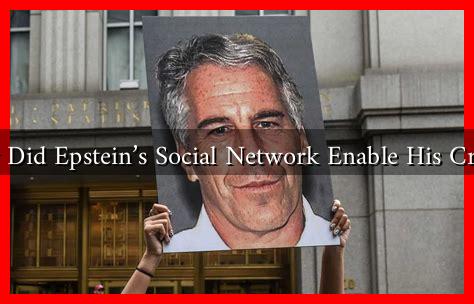-
Table of Contents
How Did Epstein’s Social Network Enable His Crimes?
The case of Jeffrey Epstein, a financier and convicted sex offender, has captivated the public’s attention and raised critical questions about the mechanisms that allowed his criminal activities to flourish. Epstein’s extensive social network played a pivotal role in enabling his predatory behavior, providing him with both the resources and the cover necessary to exploit vulnerable individuals. This article explores how Epstein’s connections facilitated his crimes, the implications of his social circle, and the lessons learned from this disturbing case.
The Power of Influence: Epstein’s Connections
Epstein’s social network was not just extensive; it was influential. He cultivated relationships with powerful figures across various sectors, including politics, business, and entertainment. This network provided him with a veneer of legitimacy and protection, which he exploited to further his criminal activities.
- Political Ties: Epstein had connections with high-profile politicians, including former President Bill Clinton and Prince Andrew of the UK.
. These relationships not only lent him credibility but also created a sense of impunity.
- Business Associates: Epstein was known to associate with wealthy businessmen and financiers, which allowed him to maintain a lifestyle that masked his illegal activities.
- Celebrity Connections: His friendships with celebrities like Naomi Campbell and Kevin Spacey helped him gain access to exclusive social circles, where he could prey on vulnerable individuals.
The Role of Enablers
Epstein’s network included not just high-profile individuals but also enablers who facilitated his crimes. These individuals played various roles, from providing logistical support to actively participating in his illicit activities.
- Ghislaine Maxwell: Epstein’s close associate, Maxwell, has been accused of recruiting and grooming young girls for Epstein. Her involvement highlights how close relationships can be exploited for nefarious purposes.
- Staff and Associates: Many individuals who worked for Epstein, including pilots and house staff, were reportedly aware of his activities but chose to remain silent, either out of fear or complicity.
The Culture of Silence and Complicity
One of the most alarming aspects of Epstein’s social network was the culture of silence that surrounded it. Many individuals who were aware of his behavior chose to ignore it, either due to fear of repercussions or a belief that he was untouchable.
- Fear of Retaliation: Epstein’s wealth and influence created a climate of fear. Victims and witnesses often felt that speaking out would lead to personal or professional harm.
- Normalization of Abuse: In some circles, Epstein’s behavior was normalized or dismissed as part of a lifestyle that included excess and privilege.
Case Studies: Victims and Their Stories
The stories of Epstein’s victims illustrate the devastating impact of his social network. Many young women were lured into his orbit through promises of financial support, modeling opportunities, or connections to influential people.
- Virginia Giuffre: One of Epstein’s most vocal accusers, Giuffre has shared her harrowing experience of being trafficked and abused, highlighting how Epstein used his connections to manipulate and control her.
- Other Victims: Numerous other women have come forward, revealing similar patterns of exploitation and abuse, often facilitated by Epstein’s network.
Lessons Learned and Moving Forward
The Epstein case serves as a stark reminder of the dangers posed by unchecked power and influence. It underscores the need for systemic changes to prevent similar abuses in the future.
- Accountability: There must be accountability for those who enable or ignore such behavior, including institutions that fail to act.
- Support for Victims: Providing resources and support for victims is crucial in breaking the cycle of silence and fear.
- Awareness and Education: Increasing awareness about the signs of exploitation and abuse can empower individuals to speak out and seek help.
Conclusion
Jeffrey Epstein’s social network was a critical enabler of his crimes, providing him with the resources, protection, and cover necessary to exploit vulnerable individuals. The relationships he cultivated, combined with a culture of silence and complicity, allowed his predatory behavior to persist for years. As society reflects on this case, it is essential to recognize the importance of accountability, support for victims, and education to prevent similar abuses in the future. The Epstein saga is not just a story of one man’s depravity; it is a cautionary tale about the dangers of unchecked power and the need for vigilance in protecting the most vulnerable among us.
For more information on the Epstein case and its implications, you can visit The New York Times.





